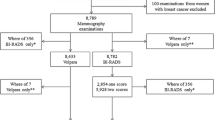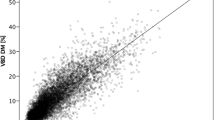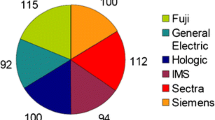Abstract
Objectives
Radiologists’ visual assessment of breast mammographic density (BMD) is subject to inter-observer variability. We aimed to develop and validate a new automated software tool mimicking expert radiologists’ consensus assessments of 2D BMD, as per BI-RADS V recommendations.
Methods
The software algorithm was developed using a concept of Manhattan distance to compare a patient’s mammographic image to reference mammograms with an assigned BMD category. Reference databases were built from a total of 2289 pairs (cranio-caudal and medio-lateral oblique views) of 2D full-field digital mammography (FFDM). Each image was independently assessed for BMD by a consensus of radiologists specialized in breast imaging. A validation set of additional 800 image pairs was evaluated for BMD both by the software and seven blinded radiologists specialized in breast imaging. The median score was used for consensus. Software reproducibility was assessed using FFDM image pairs from 214 patients in the validation set to compare BMD assessment between left and right breasts.
Results
The software showed a substantial agreement with the radiologists’ consensus (unweighted κ = 0.68, 95% CI 0.64–0.72) when considering the four breast density categories, and an almost perfect agreement (unweighted κ = 0.84, 95% CI 0.80–0.88) when considering clinically significant non-dense (A-B) and dense (C-D) categories. Correlation between left and right breasts was high (rs = 0.87; 95% CI 0.84–0.90).
Conclusions
BMD assessment by the software was strongly correlated to radiologists’ consensus assessments of BMD. Its performance should be compared to other methods, and its clinical utility evaluated in a risk assessment model.
Key Points
• A new software tool assesses breast density in a standardized way.
• The tool mimics radiologists’ clinical assessment of breast density.
• It may be incorporated in a breast cancer risk assessment model.




Similar content being viewed by others
Abbreviations
- BI-RADS:
-
Breast Imaging Reporting and Data System
- BMD:
-
Breast mammographic density
- CC:
-
Cranio-caudal
- DBT:
-
Digital breast tomosynthesis
- Md:
-
Manhattan distance
- MLO:
-
Medio-lateral oblique
- MQSA:
-
Mammography Quality Standards Act
References
Harvey JA, Bovbjerg VE (2004) Quantitative assessment of mammographic breast density: relationship with breast cancer risk. Radiology 230:29–41
Vacek PM, Geller BM (2004) A prospective study of breast cancer risk using routine mammographic breast density measurements. Cancer Epidemiol Biomarkers Prev 13:715–722
Boyd NF, Rommens JM, Vogt K et al (2005) Mammographic breast density as an intermediate phenotype for breast cancer. Lancet Oncol 6:798–808
McCormack VA, dos Santos Silva I (2006) Breast density and parenchymal patterns as markers of breast cancer risk: a meta-analysis. Cancer Epidemiol Biomarkers Prev 15:1159–1169
Boyd NF, Guo H, Martin LJ et al (2007) Mammographic density and the risk and detection of breast cancer. N Engl J Med 356:227–236
Sickles EA, D'Orsi CJ, Bassett LW et al (2013) ACR BI-RADS® atlas, breast imaging reporting and data system. American College of Radiology, Reston
Ciatto S, Houssami N, Apruzzese A et al (2005) Categorizing breast mammographic density: intra- and interobserver reproducibility of BI-RADS density categories. Breast 14:269–275
Lobbes MB, Cleutjens JP, Lima Passos V et al (2012) Density is in the eye of the beholder: visual versus semi-automated assessment of breast density on standard mammograms. Insights Imaging 3:91–99
Sprague BL, Conant EF, Onega T et al (2016) Variation in mammographic breast density assessments among radiologists in clinical practice: a multicenter observational study. Ann Intern Med 165:457–464
Ng KH, Yip CH, Taib NA (2012) Standardisation of clinical breast-density measurement. Lancet Oncol 13:334–336
Yaffe MJ (2008) Mammographic density. Measurement of mammographic density. Breast Cancer Res 10:209
Chen JH, Gulsen G, Su MY (2015) Imaging breast density: established and emerging modalities. Transl Oncol 8:435–445
Brandt KR, Scott CG, Ma L et al (2016) Comparison of clinical and automated breast density measurements: implications for risk prediction and supplemental screening. Radiology 279:710–719
Jeffers AM, Sieh W, Lipson JA et al (2017) Breast cancer risk and mammographic density assessed with semiautomated and fully automated methods and BI-RADS. Radiology 282:348–355
Aitken Z, McCormack VA, Highnam RP et al (2010) Screen-film mammographic density and breast cancer risk: a comparison of the volumetric standard mammogram form and the interactive threshold measurement methods. Cancer Epidemiol Biomarkers Prev 19:418–428
Wanders JOP, Holland K, Karssemeijer N et al (2017) The effect of volumetric breast density on the risk of screen-detected and interval breast cancers: a cohort study. Breast Cancer Res 19:67
Kerlikowske K, Ma L, Scott CG et al (2017) Combining quantitative and qualitative breast density measures to assess breast cancer risk. Breast Cancer Res 19:97
Astley SM, Harkness EF, Sergeant JC et al (2018) A comparison of five methods of measuring mammographic density: a case-control study. Breast Cancer Res 20:10
Destounis S, Arieno A, Morgan R, Roberts C, Chan A (2017) Qualitative versus quantitative mammographic breast density assessment: applications for the US and abroad. Diagnostics (Basel) 7:30
Cohen J (1960) A coefficient of agreement for nominal scales. Educ Psychol Meas 20:37–46
Cohen J (1968) Weighted kappa: nominal scale agreement with provision for scaled disagreement or partial credit. Psychol Bull 70:213–220
Landis JR, Koch GG (1977) The measurement of observer agreement for categorical data. Biometrics 33:159–174
Youk JH, Gweon HM, Son EJ, Kim JA (2016) Automated volumetric breast density measurements in the era of the BI-RADS fifth edition: a comparison with visual assessment. AJR Am J Roentgenol 206:1056–1062
Sartor H, Lång K, Rosso A, Borgquist S, Zackrisson S, Timberg P (2016) Measuring mammographic density: comparing a fully automated volumetric assessment versus European radiologists' qualitative classification. Eur Radiol 26:4354–4360
Gastounioti A, Conant EF, Kontos D (2016) Beyond breast density: a review on the advancing role of parenchymal texture analysis in breast cancer risk assessment. Breast Cancer Res 18:91
Malkov S, Shepherd JA, Scott CG et al (2016) Mammographic texture and risk of breast cancer by tumor type and estrogen receptor status. Breast Cancer Res 18:122
Wang C, Brentnall AR, Cuzick J, Harkness EF, Evans DG, Astley S (2017) A novel and fully automated mammographic texture analysis for risk prediction: results from two case-control studies. Breast Cancer Res 19:114
Independent UK Panel on Breast Cancer Screening (2012) The benefits and harms of breast cancer screening: an independent review. Lancet 380:1778–1786
Kerlikowske K (2009) Evidence-based breast cancer prevention: the importance of individual risk. Ann Intern Med 151:750–752
Weigert J, Cavanaugh N, Ju T (2018) Evaluating mammographer acceptance of MammoRisk software. Radiol Technol 89:344–350
Kopans DB (2008) Basic physics and doubts about relationship between mammographically determined tissue density and breast cancer risk. Radiology 246:348–353
Hooley RJ, Durand MA, Philpotts LE (2017) Advances in digital breast tomosynthesis. AJR Am J Roentgenol 208:256–266
Gweon HM, Youk JH, Kim JA, Son EJ (2013) Radiologist assessment of breast density by BI-RADS categories versus fully automated volumetric assessment. AJR Am J Roentgenol 201:692–697
Acknowledgments
The authors would like to thank Sylvie Phung (Predlife, France) for her technical support and Sandra Canale (Gustave Roussy, France) for her clinical support.
Funding
This study has received funding by Fondation ARC pour la Recherche.
Author information
Authors and Affiliations
Corresponding author
Ethics declarations
Guarantor
The scientific guarantor of this publication is Dr. Corinne Balleyguier.
Conflict of interest
Emilien Gauthier, Valerie Helin, and Stephane Ragusa, authors of this manuscript, declare relationships with Predlife (Villejuif, France). Predlife, which developed the DenSeeMammo algorithm, did not support the study, but provided their software tool for the study. Non-employee authors had complete control of the data and information that might present a conflict of interest to the authors who are employees of Predlife.
Statistics and biometry
One of the authors has significant statistical expertise.
Informed consent
Written informed consent was not required for this study because it is a retrospective analysis of imaging datasets.
Ethical approval
Institutional review board approval was obtained.
Methodology
• retrospective
• observational
• multicenter study
Additional information
Publisher’s note
Springer Nature remains neutral with regard to jurisdictional claims in published maps and institutional affiliations.
Electronic supplementary material
ESM 1
(DOCX 158 kb)
Rights and permissions
About this article
Cite this article
Balleyguier, C., Arfi-Rouche, J., Boyer, B. et al. A new automated method to evaluate 2D mammographic breast density according to BI-RADS® Atlas Fifth Edition recommendations. Eur Radiol 29, 3830–3838 (2019). https://doi.org/10.1007/s00330-019-06016-y
Received:
Revised:
Accepted:
Published:
Issue Date:
DOI: https://doi.org/10.1007/s00330-019-06016-y




